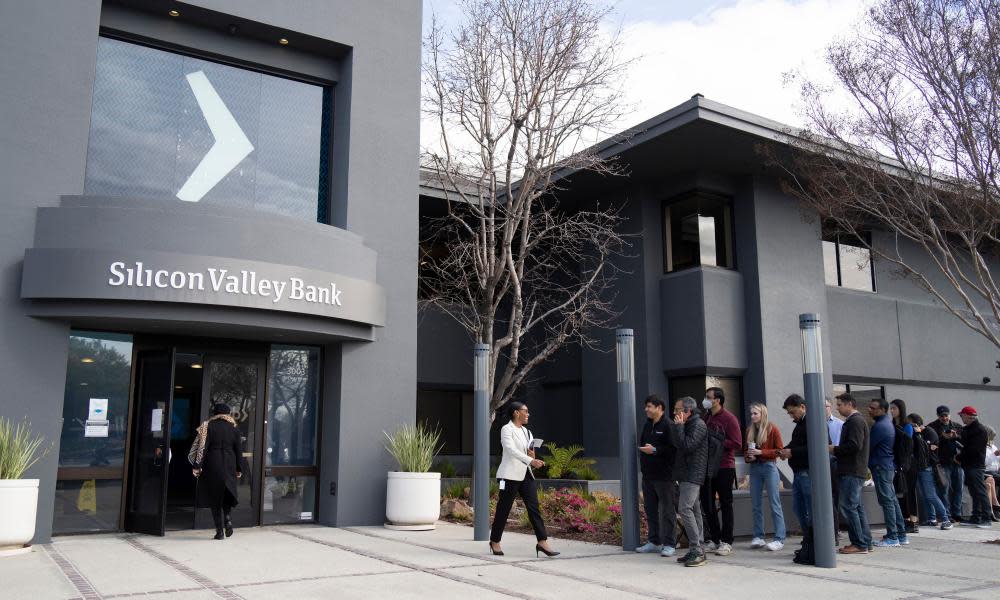The SVB debacle has exposed the hypocrisy of Silicon Valley

So one day Silicon Valley Bank (SVB) was a bank, and then the next day it was a smoking hulk that looked as though it might bring down a whole segment of the US banking sector. The US government, which is widely regarded by the denizens of Silicon Valley as a lumbering, obsolescent colossus, then magically turned on a dime, ensuring that no depositors would lose even a cent. And over on this side of the pond, regulators arranged that HSBC, another lumbering colossus, would buy the UK subsidiary of SVB for the princely sum of £1.
Panic over, then? We’ll see. In the meantime it’s worth taking a more sardonic look at what went on.
The first thing to understand is that “Silicon Valley” is actually a reality-distortion field inhabited by people who inhale their own fumes and believe they’re living through Renaissance 2.0, with Palo Alto as the new Florence. The prevailing religion is founder worship, and its elders live on Sand Hill Road in San Francisco and are called venture capitalists. These elders decide who is to be elevated to the privileged caste of “founders”.
To achieve this status it is necessary to a) be male; b) have a Big Idea for disrupting something; and c) never have knowingly worn a suit and tie. Once admitted to the priesthood, the elders arrange for a large tipper-truck loaded with $100 bills to arrive at the new member’s door and cover his driveway with cash.
But this presents the new founder with a problem: where to store the loot while he is getting on with the business of disruption? Enter stage left one Gregory Becker, CEO of SVB and famous in the valley for being worshipful of founders and slavishly attentive to their needs. His company would keep their cash safe, help them manage their personal wealth, borrow against their private stock holdings and occasionally even give them mortgages for those $15m dream houses on which they had set what might loosely be called their hearts.
The most striking takeaway was the evidence produced by the crisis of the arrant stupidity of some of those involved
So SVB was awash with money. But, as programmers say, that was a bug not a feature. Traditionally, as Bloomberg’s Matt Levine points out, “the way a bank works is that it takes deposits from people who have money, and makes loans to people who need money”. SVB’s problem was that mostly its customers didn’t need loans. So the bank had all this customer cash and needed to do something with it. Its solution was not to give loans to risky corporate borrowers, but to buy long-dated, ostensibly safe securities like Treasury bonds. So 75% of SVB’s debt portfolio – nominally worth $95bn (£80bn) – was in those “held to maturity” assets. On average, other banks with at least $1bn in assets classified only 6% of their debt in this category at the end of 2022.
There was, however, one fly in this ointment. As every schoolboy (and girl) knows, when interest rates go up, the market value of long-term bonds goes down. And the US Federal Reserve had been raising interest rates to combat inflation. Suddenly, SVB’s long-term hedge started to look like a millstone. Moody’s, the rating agency, noticed and Mr Becker began frantically to search for a solution. Word got out – as word always does – and the elders on Sand Hill Road began to whisper to their esteemed founder proteges that they should pull their deposits out, and the next day they obediently withdrew $42bn. The rest, as they say, is recent history.
What can we infer about the culture of Silicon Valley from this shambles? Well, first up is its pervasive hypocrisy. Palo Alto is the centre of a microculture that regards the state as an innovation-blocking nuisance. But the minute the security of bank deposits greater than the $250,000 limit was in doubt, the screams for state protection were deafening. (In the end, the deposits were protected – by a state agency.) And when people started wondering why SVB wasn’t subjected to the “stress testing” imposed on big banks after the 2008 crash, we discovered that some of the most prominent lobbyists against such measures being applied to SVB-size institutions included that company’s own executives. What came to mind at that point was Samuel Johnson’s observation that “the loudest yelps for liberty” were invariably heard from the drivers of slaves.
But the most striking takeaway of all was the evidence produced by the crisis of the arrant stupidity of some of those involved. The venture capitalists whose whispered advice to their proteges triggered the fatal run must have known what the consequences would be. And how could a bank whose solvency hinged on assumptions about the value of long-term bonds be taken by surprise by the impact of interest-rate increases? All that was needed to model the risk was an intern with a spreadsheet. But apparently no such intern was available. Perhaps s/he was at Stanford doing a thesis on the Renaissance.
What I’ve been reading
Crypto crisis
The Death of Cryptocurrency is a fascinating – and astute – Yale Law School white paper by Nicholas Weaver.
Her revisited
The New Yorker has a lovely review essay by Brian Christian on Spike Jonze’s movie Her – a film with ChatGPT resonances. It is titled The Samantha Test.
Sole purpose
Reuters’s feature “Dow said it was recycling our shoes. We found them at an Indonesian flea market” is a really nice example of good investigative reporting.

 Yahoo News
Yahoo News 
